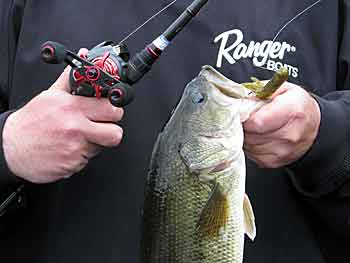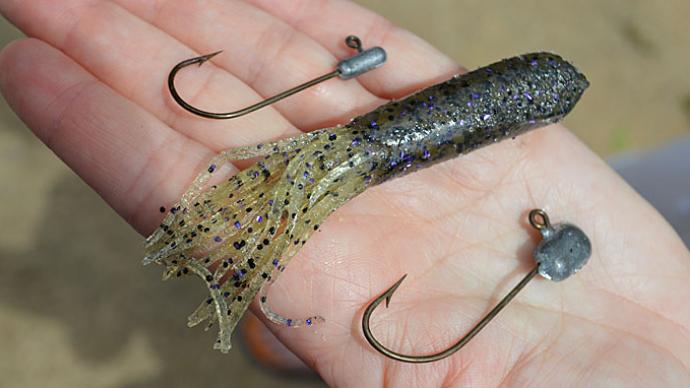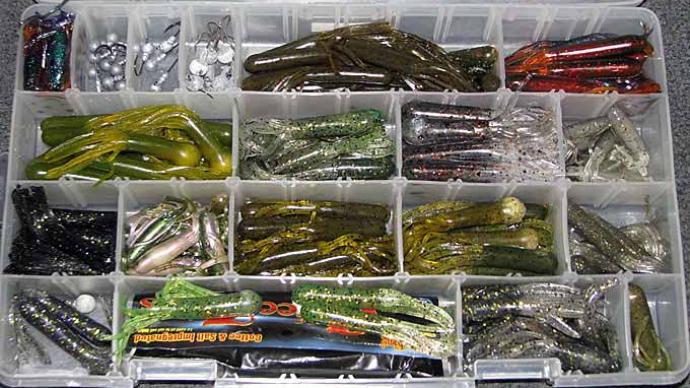
The names Bobby and Garry Garland are certain to be enshrined in the Freshwater Fishing Hall of Fame one day due to the original tube bait the brothers developed called the Gitzit. They invented the lure to help them catch finicky fish on Lake Mead in Arizona. It is still one of the best finesse baits ever designed. There are many knock-offs, but many anglers insist that the original Gitzit is the best. Sadly Bobby and Garry have both passed on. I met up with Garry a few years before he died and fished Roosevelt with him.
When conditions are tough, a tube is one of the best go-to baits. Anytime the tube or the water moves, the bait's tail is moving, creating action. Garry said that a tube mimics a crawdad or a bait fish, and there are plenty of colors to help you match the forage on your home lake.
When Garry pre-fished, he always put the first fish he caught in the livewell. After an hour or so, he’d take a peek. “Usually, the bass spit up a little something, and that’s how I decide what color I will use,” he said. “ If the bass spits up a shad, I’ll use a shad color. If he was feeding on craws, I’d choose a darker color.”
There are tons of ways to fish tubes. A lot of anglers have gotten away from them over the years. This has made the tube even more productive. Tubes are great baits to start kids with because they are so easy to fish and forgiving. The key to fishing a Gitzit is the rigging, Garland told us. Match the rigging and the tube to the conditions, and you’ll catch fish. He preferred the 3-inch tube for deep fish or shallow fish that are spooky. The bigger tubes are the ones he used the most, and he rigged them on various lead heads.

For very shallow fishing, a small 1/16-ounce dart head is ideal. The head can be rigged inside the bait or outside. If you rig it with the head outside, it makes the bait fall faster. A Gitzit is usually considered a drop bait, performing magnificently well at this task. If you fish it on light line and give it some controlled slack, it spirals down with an action unmatched by any other lure. But you can also fish Gitzits down deep on the bottom, use them to probe structure, and even flip the big tubes into heavy cover.
To mimic a crawdad, rig a dark Gitzit on a rocker-head jig. This lets the tube stand straight up on the bottom. When you pull on the line, it crawls along a bit, then when you stop, it stands up and waves its tentacles around enticingly, like a craw waving its arms. This bottom-rigged tube can be bounced down a bluff, dragged down a point, or even pumped through a school of suspended fish. If you want a prolonged fall, choose a 4 ½-inch tube and rig it on a 1/32-ounce jig head. The bulk of the tube and the tiny jig head make the bait fall very slowly.
The 5-inch and 6-inch Gitzits are dynamite for flippin’, specially rigged with a pegged sinker. A hook with a wide gap is a must, or you can use a big shiner hook and rig it so that the hook is inside the bait with just the tip of the point Tex-posed.
Presentation
When you cast a tube to brush, cast past your target and bring the tube up to it before letting it fall on a slack line. To fish a tube properly, you have to be a line watcher. Most of the bites will just be pressure, or you’ll see your line twitch or move to the side. Ensure you leave slack in the line, or the lure will pendulum away from the brush. You want the tube to spiral down right into the thick of things.
Fishing a bluff is often your best bet on cold, windy days. On bluffs or steep banks, cast the tube out on a ¼-ounce head and let it bounce down the wall. You can fish it like a Westy Worm, letting it settle until the line goes slack, then moving it just a little with the rod tip. This will let it fall to the next ledge.
When fish are suspended, they aren’t always inactive. Stripers and white bass are almost always suspended, and sometimes largemouth and smallmouth bass are away from structure but still on the feed. When this is the case like if you see boils, cast a tube past the boil, then fish it back through with a pumping action. If you see fish on the graph, count the lure down to the proper depth before pumping it back.
People often forget that Gitzits make dynamite split-shot and drop-shot baits. The hollow design means that the tubes float beautifully. The thing is, once the air escapes, the tube starts its unique spiral fall. If you want the tube to stay floating, you can use a piece of a Styrofoam to plug the hole.
A “plugged” tube will stay buoyant – they make great drop-shot and split-shot baits. When you tug a Gitzit around on a split-shot rig, it dips and darts while you’re moving the line, then it suspends there above the bottom with those tentacles waving around. Hard to resist!
When tube lures first came out, people immediately started experimenting with them. Some guys were putting Alka-Seltzer inside the tube so the fizzing would get attention from any nearby fish. Others, especially those fishing the tube as a drop bait, were stuffing a bit of cotton inside and soaking the cotton with scent. The scent that contains glitter would leave a smelly, sparkly trail like a wounded minnow losing scales as he falls to the bottom.
The larger Gitzits can even be fished like rip bait. A hook with a weight on the shaft near the bend works well for this technique, or you can squeeze a small split-shot such as a Water Gremlin Bull Shot or Pinch Grip onto the hook. A Gitzit rigged like this works almost like a Slug-Go but with the added attraction of the waving tentacles. Use the cotton ball with scent idea to add even more attraction to the lure. Just cast it to shore, let it fall to about a count of five, then start twitching it back. Pause when it gets next to good looking cover, and hang on.
Garry told us that the main thing to remember when fishing a Gitzit is to be patient and let it do its thing. “Don’t move the rod much when the tube is falling,” he said, “and be patient. Also, keep an eye on your line, or you’ll miss most of the bites.”
Tora Tubes

Tora tubes were all the rage in southern California when they first came out. A Tora Tube is big: at seven inches long, it has a big enough hollow body that you can stuff a football head jig inside it if you want. It makes a dynamite swimbait and gives tons of action. You don’t have to worry about it falling over on its side.
The best time of year to try a Tora Tube is early spring. It’s good on pre-spawn fish and dynamite on big bed fish, too. Since the Tora Tube is so big, it’s easy to get short strikes. You can add a stinger hook by tying some line onto the eye of the hook you’re using. Keep a nice long tail on the line, and then tie on a big treble hook so that it is about two inches behind the leading hook. A huge 8/0 hook works best for a Tora Tube, with the treble stinger similarly sized.
Try throwing the Tora Tube onto shallow bedding flats, especially those with quick access to deep water. You can swim and twitch them down long points, too. To get it down deeper, add a big bullet sinker in front, pegged, or use a large jig stuffed down the tube. Use a great big shiner hook and rig it weedless for a deadly Carolina rig, or stuff a big spoon inside it and use it as a drop bait for giant deep-water bass.
If you haven’t fished a tube lure lately, you’re ignoring one of the best lures in the country. Tubes in various sizes will catch everything from bluegills to colossal saltwater fish, and they were invented by Arizona anglers who needed to catch bass on clear-water lakes. Pick up a package of tubes, and pretty soon, you’ll wonder how you ever got along without them.




